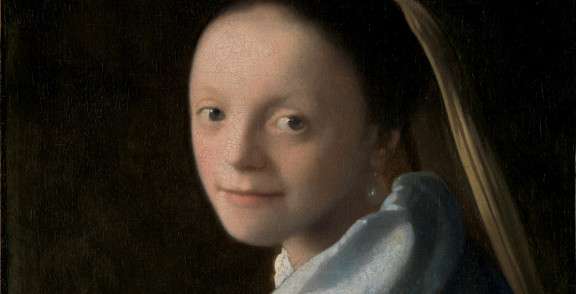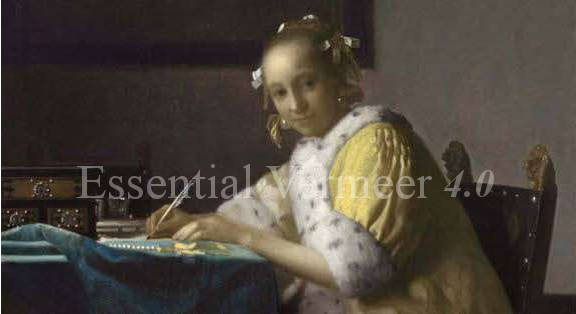"Delft's era as an artistic hub was notably short-lived, beginning in the mid-1640s and fading after the 1660s, with Vermeer being an exceptional figure beyond this period. In the early seventeenth century, Delft's strength was in portrait painting with artists like Michiel van Mierevelt (1566–1641). The influx of Flemish artists did not significantly alter this, as Delft lacked the kind of influential artists found in other Dutch cities, potentially due to its conservative culture which favored craftsmanship over innovation, which may have impeded the development of the dynamic Baroque style flourishing elsewhere.
"By 1640, the artists in Delft had yet to form a cohesive school of painting, operating independently without significant influence on each other. It was only in the late 1640s and early 1650s that shared interests and trends began to emerge, particularly with the arrival of artists like Paulus Potter (1625–1654), Emanuel de Witte (1617–1692), Carel Fabritius (1637–1673), and Pieter de Hooch (1629–1684). This group, including Delft natives like Gerard Houckgeest (c. 1600–1661) and later Vermeer, developed a mutual appreciation for light, air, and perspective.
"A distinct Delft style evolved by the mid-1650s, recognized for its classicizing tendencies that appealed to the local elite's preference for fine craftsmanship. However, this artistic community was fragile and quickly declined with the deaths and departures of key figures. By 1660, many talents had moved to Amsterdam, and Vermeer's leadership role in the guild saw a diminished group. The decline continued with the city's focus shifting towards its faience industry,Faience is a form of fine tin-glazed pottery, which has a white, opaque, and brightly colored glaze. It originated in the Near East and was brought to Europe through the Islamic influence on Spain. The term "faience" is derived from the city of Faenza in Italy, which was a major center of pottery production during the Renaissance, though the technique itself was used in various locations across Europe. and despite the presence of some talented artists, the innovative spark had largely been lost. Vermeer remained a notable exception, continuing his work in Delft even as others left for greater opportunities.John Michael Montias, "Painters in Delft, 1613-1680," Simiolus: Netherlands Quarterly for the History of Art 10, no. 2 (1978-1979):105.
The artists of the School of Delft, as this loosely composed of a heterogeneous group of artist is referred to today, were mostly born outside Delft but worked there at one time or another for varying lengths of time between 1650 and 1670. According to some art historians, there was, however, no pivotal figure in Delft (least of all Vermeer) around whom the other painters gathered for inspiration although at one time or another Fabritius, Pieter Saenredam (1597–1665), Paulus Potter and even Nicolaes Maes (1634–1693) have been cast in the role of catalysts. Certainly, none of these painters would have ever thought of themselves as belonging to a "school."
 fig. 1 Peasants by a Fire
fig. 1 Peasants by a FireLeonaert Bramer
c. 1626
Oil on slate, 22 x 33 cm.
Private collection
Leonaert Bramer (1596–1674), who would have been acknowledged by Delft citizens as the most important Delft painter of his generation, produced eccentric history paintings, murals and moody Italianate nocturnal scenes (fig. 1) which share nothing with the work of Vermeer and his pioneering colleagues. The other important painter in Delft was Christiaen van Couwenberg (1604–1667), who, like Bramer, made primarily history paintings and had studied in Italy. His paintings of Biblical subject matter, for modern taste, appear theatrical and brittle, practically at the antipode of the Delft spirit.
Any scenario that might explain how the Delft spirit was ignited must include the contemporary gathering of Fabritius from Amsterdam (and with him the lessons of Rembrandt), De Hooch from Rotterdam (a painter of amiable low-life scenes), Paulus Potter (noted for his silvery, atmospheric landscapes) and the pioneering architectural painters, Gerard Houckgeest and Emmanuel de Witte along with Vermeer, native of Delft.
We know that Italian artists and art writers of the Renaissance thought the artistic production from each of the major Italian cities (Rome, Florence and Venice) presented distinct characteristics distinguishing them from the others. There is no documentary evidence showing that painters of Amsterdam, Haarlem or Utrecht had ever viewed the more innovative art production of Delft distinct from the production of other cities—nough so to merit an appellative. Nor is it known if the painters of the School of Delft themselves held that there was a common thread binding them together. Vermeer may have urged the awkward De Hooch (fig. 2) to draw his figures and organize his compositions with greater care, but if Vermeer's white-washed walls owe more to the pearl-gray church walls of Houckgeest or De Witte rather than to the stark white background of Fabritius's tiny GoldfinchThe painting depicts a life-size European goldfinch (Carduelis carduelis) perched on the upper ring of a feeder, which is a blue container with a lid, fixed to the wall with two wooden half-rings. The bird's leg is attached to the ring by a fine chain. The artwork is signed and dated "C fabritivs 1654" at the bottom. The goldfinch, common across Europe, North Africa, and parts of Asia, is known for its colorful appearance and pleasant song. It has been domesticated for over 2,000 years, valued for its believed health and good fortune properties. Notably, in the 17th century, it became popular to train goldfinches to draw water using a miniature bucket on a chain. The Dutch title of the painting, 'puttertje,' refers to this practice, translating to "draw-water," akin to an old Norfolk name for the bird. is impossible to know. A significant number of the paintings produced in Delft are not dated, frustrating attempts to determine the directions of influence with any degree of accuracy.
On the other hand, it is almost impossible to believe that in a city as small as Delft, which at that time could have been be crossed by foot in a few minutes, such exceptionally talented painters belonging to the same guild would not have talked shop and kept a close eye on their colleagues' progress, if nothing else in order not to fall behind in competition.
Characteristics of the School of Delft
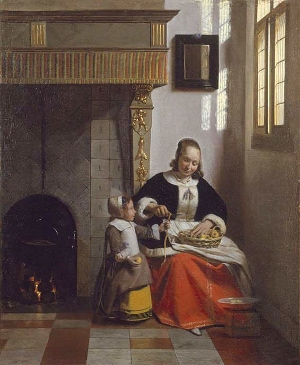 fig. 2 A Woman Peeling Apples
fig. 2 A Woman Peeling ApplesPieter de Hooch
c. 1663
Oil on canvas, 67.1 x 54.7 cm.
The Wallace Collection, London
The School of Delft is known for genre scenes of domestic life, church interiors, courtyards and its city streets. The principal artists of the School of Delft are Johannes Vermeer, Pieter de Hooch, Carel Fabritius, Gerard Houckgeest, Paulus Potter and Emmanuel de Witte. Today, Vermeer is universally considered the greatest painter of the school although each of painters listed above have carved out a prestigious place among the most significant painters of the Golden Age of Dutch painting.
Other painters who, to a greater or lesser degree, have been associated with the School are Hendrick van der Burch , Cornelis de Man (1621–1706), Anthonie Palamedesz (1602–1673), Egbert van der Poel (1621–1664), Adam Pynacker (1622–1673), Jan Steen (1626–1679), Jacob van Velsen (1597–1656), Johannes Verkolje (1650–1693), Hendrick Cornelisz van Vliet (1611/1612–1675), Daniel Vosmaer (c. 1630–after 1666), and Jacob Woutersz Vosmaer.
The principle qualities which distinguish the painting of the School of Delft from the painting of other Dutch schools is a pervading calm, careful observation of the activity of light, perspective coherency, measured composition and a relative disinterest for detail for the sake of detail. The last is the quality which brought the fijnschilders (fine painters) of the Leiden SchoolThe Fijnschilders (literally "fine-painters"), also called the Leiden Fijnschilders ('Leidse Fijnschilders'), were Dutch Golden Age painters who, from about 1630 to 1710, strove to create as natural a reproduction of reality as possible in their meticulously executed, often small-scale works. to the international stage.
The School of Delft coalesced in the early 1650s and continued to produce paintings of elevated quality and originality through the 1660s. However, as quickly as the Delft style arose, it disappeared. Many artists departed for more promising markets, usually Amsterdam. By the time Vermeer died in 1675, the city had reverted to its status as an artistic backwater.
The character or even the existence itself of the School of Delft—no such appellation existed at the time—is not, however, set in stone. J. Breunesse holds that "with the use of the term 'Delft School,' a problem [is] created rather than solved." Adriaan Waiboer posited that even though Delft displayed a temporary synergy among a handful of painters that resulted in a body of work that collectively looked differently from that of other towns, the number of artists involved was too small and the period during which they jointly flourished too short to maintain that the city had local "schools."Adriaan Waiboer, "Vermeer and the Masters of Genre Painting," in Vermeer and the Masters of Genre Painting: Inspiration and Rivalry, edited by Adriaan Waiboer and Eddy Schavemaker (London and New Haven: Yale University Press, 2017), 9.
On the other hand, in line with previous art historians, John M. Montias, the economist turned Vermeer biographer, suggests that once Potter, De Witte, Fabritius, De Hooch, and Vermeer joined the Delft Guild of Saint Luke shortly before or shortly after 1650s, "a genuine school—in the sense of a community with intersecting interests in subject matter and techniques, with some similarity in aesthetic approaches, and with significant cross influences—had at last come into existence."
Walter Liedtke, one of the most authoritative scholars of Dutch art, affirmed unequivocally that the School of Delft did exist and organized in its honor an imposing exhibition at the Metropolitan Museum of Art which included 85 paintings, 15 by the hand of Vermeer. Walter Liedtke, curator, Vermeer and the Delft School, Tisch Galleries, second floor, Metropolitan Museum of Art, New York, March 8-May 27, 2001. Briefly, Liedtke asserts that "most innovative Delft artists of the 1650s and 1660s achieved (unconsciously, to be sure) a synthesis of qualities that were well established in Delft and the naturalistic mode of description that had been at home in Haarlem, 'Cradle of the New Art.'"
In any case, as Liedtke points out, the most recent art historical research has concentrated more on the individualities of the painters working in Delft and their relationship to the broader context of South Holland rather than with the School of Delft. Some critics maintain that the "regional" differences in the arts are less marked in the Netherlands, united as it was by strong bonds of commerce and a highly efficient system of transportation.
- Brown, Christopher. Carel Fabritius with a Catalogue Raisonné. Oxford: Phaidon, 1981.
- Duparc, Frederik J., Gero Seelig, and Ariane Van Suchtelen. Carel Fabritius 1622–1654. The Hague: Royal Cabinet of Paintings, Mauritshuis, 2004.
- Franits, Wayne. Pieter de Hooch: A Woman Preparing Bread and Butter for a Boy. Getty Museum Studies on Art. Los Angeles: Getty Museum, 2006.
- Jantzen, Hans. Das niederländische Architekturbild. 2nd ed. Brunswick, 1979. First published 1910, Leipzig.
- Liedtke, Walter A. A View of Delft: Vermeer and his Contemporaries. Zwolle: Waanders Publications, 2000.
- Liedtke, Walter A., Michiel Plomp, and Axel Rüger. Vermeer and the Delft School. New York: Metropolitan Museum of Art, 2001.
- Liedtke, Walter. Architectural Painting in Delft: Gerard Houckgeest, Hendrick Van Vliet, Emanuel De Witte. Doornspijk: Davaco, 1982.
- Liedtke, Walter A. "De Witte and Houckgeest: Two New Paintings from Their Years in Delft." The Burlington Magazine 128, no. 1004 (Nov. 1986): 802–805.
- Lokin, Danielle, and Michiel C. Kersten. "The Delft Church Interior." In Delft Masters, Vermeer's Contemporaries. Zwolle: Waanders Publications, 1996, 41–86.
- Manke, Ilse Ruth. Emanuel De Witte: 1617–1622. Amsterdam: Hertzberger, 1963.
- Michalski, Sergiusz. "Rembrandt and the Church Interiors of the Delft School." Artibus et Historiae 23, no. 46 (2002): 183–193.
- Schwartz, Gary. "With Emanuel de Witte in the Oude Kerk in Amsterdam." In Geest en gratie: Essays Presented to Ildiko Ember on Her Seventieth Birthday, edited by Orsolya Radványi, 84–91. 2001.
- Sutton, Peter C. Pieter De Hoogh: Complete Edition. Oxford: Phaidon, 1980.
- Walsh, Amy L. Paulus Potter: His Works and Their Meaning. Ann Arbor: Columbia University, 1989.
- Wheelock, Arthur K., Jr. "Gerard Houckgeest and Emmanuel de Witte: Architectural Painting in Delft around 1650." Simiolus 8 (1975/76): 167–185.
Domestic Genre Scenes from 1600 to 1650
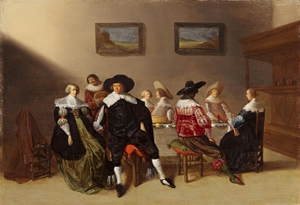 fig. 3 A Wedding Breakfast
fig. 3 A Wedding BreakfastAnthonie Palamedesz
Oil on panel, 48.4 x 73 cm.
Private collection
While busy kitchen scenes, chocked with food and kitchenware to show off the painter's ability to render textures, abounded in the sixteenth century, domestic scenes were more generally executed in drawings and etchings. Only in the new century did the domestic setting come into its own as a distinct motif.
In the first half of the 1600s artists such as Willem Buytewech (1591/92–1624), Dirck Hals (1591–1656), Pieter Codde (1599–1678), Jacob Duck (1599-1678), Willem Duyster (1599–1635), and Anthonie Palamedesz (1602–1673) painted numerous interior scenes, crowded with figures of the jeunesse dorée, "Jeunesse dorée" is a French term that translates to "golden youth" in English. It refers to a social or cultural phenomenon where young people, often from affluent or privileged backgrounds, are associated with a luxurious lifestyle, fashion, and a carefree attitude. but with minimally defined interiors (fig. 3) .
The interior environment—generally, only the background wall and floor are represented—contain no more than two or three simple pieces of furniture placed at the extreme left- or right-hand side of the composition. Perhaps, a table is placed in the middle of the composition around which the animated figures gather. The background walls are generally nude or adorned with quickly sketched wall maps or framed paintings while the floors are bare or covered with prosaic wooden planks. The windows, if visible, are roughly defined. Raking light streams over the background wall from left to right, gradually diminishing as it distances itself from the source of light. In some of the later interiors, a shadow descends diagonally from the left-hand side of the composition, suggesting the window's bottom. One has the impression that furniture and architectural features are rendered free-hand without the aid of geometrical perspective.
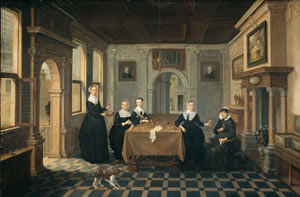 fig. 4 An Interior with Women
fig. 4 An Interior with WomenDirck van Delen
1652
Oil on panel, 94.1 x 141.8 cm.
Rijksmuseum, Amsterdam
While the figures and their fancy costumes, the raison d'être of the painting, are defined with brilliant tints and meticulous detail, the interiors themselves are summarily painted in dull earth colors. The figures often span the entire width of the composition creating a frieze-like procession. Perhaps, it is only the interiors of Anthonie Palamedesz, born in Delft, in which we might anticipate something of the cool, blond light characteristic of the School of Delft.
"Occasionally, architectural painters like Dirck van Delen (c. 1605–1671) executed secular interiors with companies of merry makers with pronounced perspective effects (fig. 4) , but these tended to be large Renaissance-styled banqueting halls which, like their church interiors and outdoor colonnades, reveal their ancestry in perspective recipes. A handful even anticipate the Delft painters' focus on the corner of an orderly interior, but make little attempt to depict natural light or a sense of atmosphere."Peter C. Sutton, Pieter De Hoogh: Complete Edition (Oxford: Yale University Press and Wadsworth Atheneum, 1980), 52.
Domestic Genre Scenes of the School of Delft
Although modeled on the consolidated left-hand-corner-of-the-room formula that had originated in the broader South Holland, Delft domestic genre interiors display figures that are set further back in the pictorial space. Delft interiors are typically higher than they are wider allowing the painter to concentrate his attention on a few, tightly knit figures (fig. 5) . Rather than spirited actors upon an empty stage of earlier interiors who cavort, drink wine and gesticulate for the divertimento of the painter and his audience, the figures of the interior scenes produced in Delft strike the spectator as real people, going about their real lives in a real environment. The figures and their actions in Delft painting are sometimes rendered with such discretion that the storyline, to say nothing of the scene's ancillary iconographic meaning, has proved vexing to interpret. Nonetheless, although generally motionless, the figures give the impression of being in harmony with their environment and themselves, absorbed in their momentary activity, unaware of the spectator.
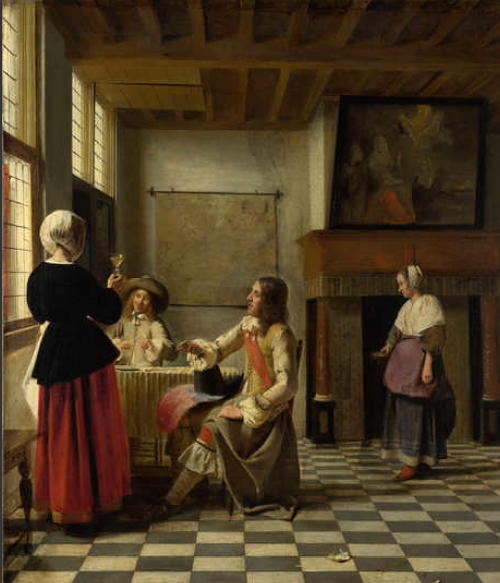 fig. 6
A Woman Drinking with Two Men
fig. 6
A Woman Drinking with Two MenPieter de Hooch
1658
Oil on canvas, 73.7 x 64.6 cm.
National Gallery, London
Although scholars have discovered that these interior scenes are a contrived combination of fact and fiction, most spectators feel as if they are able to witness real events that took place in a Dutch home more than three hundred years ago. Vermeer brought the Delft interior painters' proclivity for understatement and reserve to what has been described by the authoritative Vermeer critic Lawrence Gowing and accepted by the majority of Vermeer experts, as reticence.Lawrence Gowing, Vermeer (Oakland CA: University of California Press, 1997), reprint edition.
What is a "school" of painting?
What is a "school" of painting? In reference to painting, the word "school" is used with various meanings. In its widest sense, a school may include the painters of a single country, regardless of the date, such as "the Dutch School." In its narrowest sense, it denotes a group of painters who worked under the influence of a single artist, as in the "School of Raphael" or the "School of Rembrandt." In a third sense, it applies to the painters of one city or province who worked under some common local influence, and with some general similarity of design, color, or technique, such as "the Florentine School."
Painters of a specific geographical area were once bound together more closely than in modern times. To legally produce and sell their works, they were required to belong to the Guild of St. Luke, the corporation of artists and artisans which regulated the local art commerce and assisted painters in illness and old age. Each guild had a clearly defined set of rules and traditions and a system of apprenticeship that compelled young painters to work for a term of four to six years with a recognized guild master. Thus, an important master might stamp his manner of working on a large number of pupils, many of whom readily acquiesced to the tastes of local collectors who had guaranteed their master's prosperity.
The classification of genre painters by location is supported by localized artistic trends, particularly in Leiden and Haarlem, which were the only Dutch cities with a homogeneous production of genre scenes after 1650. In Leiden, the influence of Gerrit Dou and his student Frans van Mieris was significant, lasting into the early eighteenth century. Haarlem was notable for its peasant imagery, influenced by the Bruegelian tradition. Other Dutch cities Dordrecht experienced brief collaborative periods among artists, but these were not extensive enough to form distinct local "schools." Major cities like Amsterdam, The Hague, and Rotterdam, despite housing accomplished genre painters, did not develop a unified style. Utrecht, once significant in genre painting, lost its influence in this field after 1650.Adriaan Waiboer, "Vermeer and the Masters of Genre Painting," in Vermeer and the Masters of Genre Painting: Inspiration and Rivalry, edited by Adriaan Waiboer and Eddy Schavemaker (London and New Haven: Yale University Press, 2017), 9.
The "School of Delft," or the "Delft School," belongs to the third type of school, although its "members" would probably not have been aware that they belonged to any school at all. They were, however, bound by their obligatory guild membership and inevitably interacted with each other in a small town like Delft.
Favorite themes in Delft interior painting (all of which had evolved elsewhere) were bourgeois courtship, music making, domestic chores, discreet merry making and family life. Drawing on the work of Gerrit ter Borch (1617–1681) and Frans van Mieris (1635–1681), two of the most successful artists in the Netherlands, Vermeer extended the Delft repertoire to include letter reading and letter writing.
The domestic interior scenes painted in Delft are generally illuminated from a carefully defined window located on the left-hand extreme of the canvas, although Pieter de Hooch also employed an innovative scheme of back-lighting to silhouette the figures against light backgrounds. Light almost invariably enters from the left-hand side of the picture following convention. However, rather than serving as a vehicle for dramatizing the actions of the figures as the painters of the School of Rembrandt, the Utrecht Carravaggists and a virtual army of the Dutch low-life painters had done, the Delft painters (especially De Hooch and Vermeer) seem to have studied light for its own sake (fig. 7). This prompted some critics to state that the real subject of Vermeer's painting is light itself. Popular artificial lighting schemes in Dutch painting, such as moonlight, candlelight or torchlight, were of little interest to painters of the School of Delft. Some art historians, including Kees Kaldenbach, have hypothesized that painters in Delft had employed optical devices fitted with lenses, such as the camera obscura, to improve the mimetic quality of their images although, thus far, the instrument has only been linked securely to Vermeer.
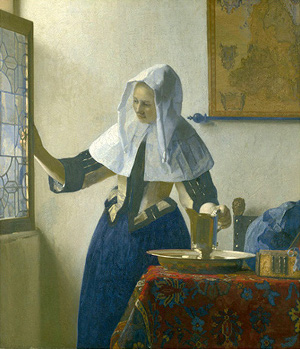 fig. 7 Young Woman with a Water Pitcher
fig. 7 Young Woman with a Water PitcherJohannes Vermeer
c. 1662–1665
Oil on canvas, 45.7 x 40.6 cm.
Metropolitan Museum of Art, New York
The overall tone of Delft domestic interior painting is generally lighter than comparable works painted elsewhere. The background walls of many interiors are light gray, the shadows are relatively luminous and cool in tone. The perspectival construction of the architectural features, including floor tiles, windows, ceiling beams and furniture, are far more coherent than those of the bourgeois interiors painted previously.
One of the principal achievements of the School of Delft was to enhance geometrical perspective—used to create a sense of three-dimensional depth—with the painterly techniques to convey light and atmosphere. The over-reliance on geometrical perspective leads to a uniform sharpness of contour creating dryness of atmosphere and brittleness of form. Architectural painters, who constructed their interiors from ground up via strict, one-point perspective, made use of precise line drawings which were subsequently transferred from the paper to the canvas through one or another mechanical procedures, without reference to a real visual model. With no visual model to rely on, color, light and shade of the final image were created by following traditional painting recipes which prescribed precise combinations of pigments for anything the painter could expect to encounter.
Pieter de Hooch
c. 1658
Oil on canvas, 65 x 60.5 cm.
Rijksmuseum, Amsterdam
Instead, Delft painters did not rely exclusively on geometric perspective to achieve the illusion of spatial depth in their pictures. They became aware, most likely through intensive observation of nature, that light, color, and contour may be used to further intensify the sensation of depth, with the advantage of simultaneously creating the sensation that natural light and air fill the room and flow around the figures and environment. Delft painters understood that warm colors and lights are perceived as advancing away from the surface of the canvas while cool colors and darks are perceived as receding, near at hand. Out of focus, or summarily painted objects, appear as more distant than meticulously painted objects with sharp contours. If an object is rendered with a saturated primary color (a technique adopted by both De Hooch and Vermeer), it will tend to stand out from surrounding objects and appear to advance in space. If the same object is rendered with weak colors, it tends to be overlooked and perceived as being more distant. Even the texture of paint may be employed to define spatial depth. By rendering objects with thick impasto, the eye is provided a sort of visual anchor making it seem tangible and "within reach." On the other hand, objects depicted with thin, diluted paint, often reserved for the secondary figures in the background, are perceived as relatively immaterial and therefore distant.
To increase the sensation of aerated space, the Delft painters rendered their shadows with lighter tones, sometimes with their own color, and equipped with reflections caused not only by the predominating lighting conditions but also from the colors and reflectivity of nearby objects (fig. 8) .
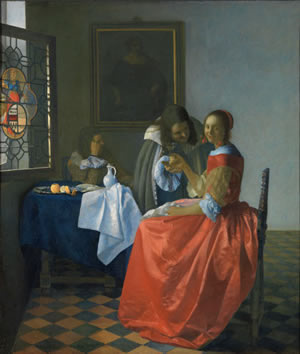 fig. 9
The Girl with a Wine Glass
fig. 9
The Girl with a Wine GlassJohannes Vermeer
c. 1659–1662
Oil on canvas, 78 x 67 cm.
Herzog Anton Ulrich-Museum, Brunswick
Vermeer's Girl with a Wine Glass (fig. 9) is a virtual compendium of the space-defining techniques typically employed by the most advanced Delft painters. The lightest passages of the girl's luxurious satin gown are depicted with unadulterated vermilion, the strongest red pigment available to painters of the time. The gown's shadows are not rendered with anonymous deep browns, conventionally used to depict shadows, but "positive" reds. Each fold is clearly delineated and the gown's outer contours are uniformly sharp. The figure virtually pops out of the picture onto the viewer's lap. In direct opposition, the dejected background figure slouching behind the table, is painted with drab earth tones. The inner contours of his clothes and anatomical features are defined by subtle shifts in tone rather than sharp chiaroscural contrasts. In places, the outer contour subtly blends into the gray background. Thus, painted so differently, the two figures break away from each other dynamically in space: one, as it were, charging to the forefront, the other, sinking into the ill-lit background. The outstanding impact of spatial depth in this work can only be appreciated when it is viewed directly, where the painting's refined surface qualities, variations in contour and nuances of color can be fully appreciated.
Once the domestic motif had been popularized, a number of painters who specialized in other subject matter, like Jacob van Loo (1614–1670) and Jan Baptist Weenix (1621–c. 1659), occasionally tried their hand at the domestic interior.
Although the School of Delft is universally renowned for its intimate interior settings, art historians agree that it was Delft church painting, which unexpectedly appeared from 1650 and 1651, that laid the groundwork for innovation rather than interior painting.
Early Church Interiors
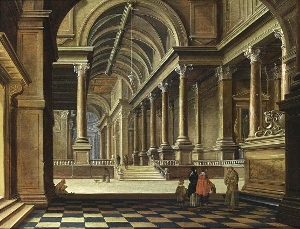 fig. 10
Interior of an Imaginary Church
fig. 10
Interior of an Imaginary ChurchBartholomeus van Bassen
1639
Oil on panel,38 x 50 cm.
Private collection
From the 1580s, the church painters of the so-called "Antwerp School" (Hendrick van Steenwyck I (c. 1550–1603)and II, Pieter Neefs the Elder (c. 1578–after 1656) and others) had tightly adhered to a rigid one-point perspective presenting a view directly down the main nave of imaginary churches. The countless orthogonals, produced by the churches' complex architectural features, race towards the vanishing point, always located within the picture, plunging the viewer's gaze headlong to the back of the painting. This device, that creates an irresistible but somewhat disquieting sense of spatial depth, continued, with some modifications, into the 1630s and 1640s by artists such as Dirck van Delen and Bartholomeus van Bassen (1590–1652). Van Bassen, for instance, had worked in Delft from 1613 to 1622. Such works were called "perspectives," a term which later came to describe not only churches or monumental structures (fig. 10) , but any painting with a pronounced effect of linear perspective, including domestic interiors, such as Vermeer's Art of Painting.
Saenredam was the first to break with tradition and record existing buildings. But more than just faithful topographical records, Saenredam's churches can be seen as portraits: an eccentric blend of fact and fiction characterized by nuanced pastel colors, natural light, and extreme simplicity of drawing and layout. Saenredam frequently omitted people and church furniture in his paintings, focusing more attention on the buildings and their architectural forms. An aura of quiet dignity and mystery, hitherto extraneous to architectural painting, pervades Saenredam's church interiors.
Church Interiors of the School of Delft
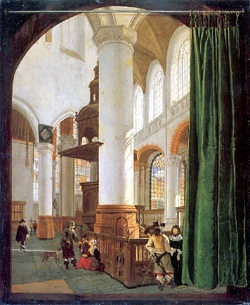 fig. 11 Interior of the Oude Kerk Delft, with the Pulpit of 1548
fig. 11 Interior of the Oude Kerk Delft, with the Pulpit of 1548Gerard Houckgeest
c. 1651
National Gallery of Scotland, Edinburgh
During the early 1650s, a small group of Delft church painters began to emphasize visual experience over fantasy. Within a few years, they brought the art of church painting to its apogee. Although Saenredam himself had no pupils or close followers, some art historians believe his works may have been a common source of inspiration for Houckgeest and De Witte, Delft's most accomplished practitioners of the specialization. Their close-up portrayals of Delft's two venerable churches, the Nieuwe and Oude Kerk, are flooded with a cool, crystal-clear daylight suggested by delicately modeled patches of diaphanous grays (fig. 11) . Huge columns are placed off-center in the very foreground of the painting, partially obscuring the viewer's access to the rest of the church. The spectator is no longer overwhelmed by the vacuous space of the earlier church scenes, but feels as if he were able to move comfortably in and around these monumental, man-made constructions, the vaunt of Delft's citizenry.
For the first time, figures, which had been previously employed as decorative filler (staffage), become an integral part of the composition. The Dutch men, women, and children who inhabit the churches appear dignified and self-possessed, not stylized dolls. The reduced dimensions of the Delft church views—the architectural paintings of the those in nearby Hague were generally much larger to suit the exigencies of the princely patronage—may have been determined by the desire to create more intimate scenery, by specific demands of the art-buying public in Delft or a combination of both.
De Witte and Houckgeest revolutionized the spatial construction of their church interiors by employing two vanishing points which converge at the nearest foreground column, from which the perspectival orthogonals recede to both sides of the composition. Both lateral vanishing points are located outside the composition. This innovation creates a natural, and intriguing spatial recession which appears to expand "behind" the picture frame creating the sense of spatial breadth as well as spatial depth. By lowering the height of the vanishing point, which had been placed higher in earlier church paintings in order to create a wide panoramic view of the scene, the viewers of De Witte's and Houckgeest's works feel as if they are located "in" the picture, with his feet firmly on the church's pavement rather than floating at an unspecified height above the floor.
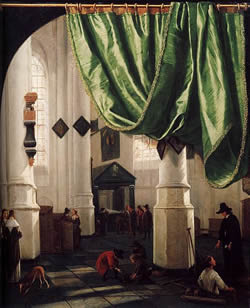 fig. 12 Interior of the Oude Kerk, Delft, with the Tomb of Piet Hein
fig. 12 Interior of the Oude Kerk, Delft, with the Tomb of Piet HeinHendrick Cornelisz. van Vliet
between 1652 and 1653
Oil on panel, 76 x 65 cm.
Private collection
In various Delft church interiors, De Witte, Houckgeest, and Van Vliet, the latter a Delft painter of minor talent, placed hanging curtains (fig. 12), sometimes brilliantly colored, to the side of the composition in order to increase the sense of spatial illusion. Sometimes the curtain's hanging rod is also represented creating the illusion that the curtain does not belong to the space of the church itself, but is located in front of the painting, imitating curtains which were hung over precious paintings in order to prevent them from collecting dust. The luxuriously colored green curtain, which appears to the right of the girl in Vermeer's Girl Reading a Letter at an Open Window, was almost certainly inspired by the church painters' trompe-l'œil motif. art historian Sergiusz Michalski traced this motif to Rembrandt, who had used it occasionally in representations of mythological or biblical scenes.Sergiusz Michalski, “Rembrandt and the Church Interiors of the Delft School,” Artibus et Historiae 23, no. 46 (2002): 183–193.
Due to the unquestionable naturalness of their works, most critics agree that De Witte and Houckgeest worked from life, although likely in the form of drawing. Painters of the time rarely set up their easels to paint in oils outdoors compared to the more abundant records of painters drawing outdoors. The exact sequence of church paintings created by Houckgeest and De Witte during the crucial period from 1650 to 1654 remains a subject of debate. The so-called "Delft-type" of church interior painting had a significant impact on the development of the artistic types in the Gouden Eeuw, the Golden Age of Dutch painting.
Courtyard Scenes
Perhaps the only motif entirely invented in Delft was the urban courtyard scene. Although Fabritius' View in Delft is generally considered to be the earliest townscape to have been painted in Delft, De Hooch brought the type to its splendid maturity. Rather than focusing on the topographical character of Delft's urban courtyards, De Hooch concentrated on rendering the weathered brick and plastered walls, foliage, reflecting water, and shimmering roof tiles in schilderachtig, or "picturesque," manner capturing the silence of daily life and the timeless routine of household work, so cherished by the Dutch people. Delft townscapes and architectural paintings of the 1650s onward have the look of personal impressions, of things too familiar and sympathetic to describe objectively.Walter Liedtke, ed., Vermeer and the School of Delft (New York: Metropolitan Museum of Art, 2001), 115.
Although Vermeer never painted courtyards per se, his two street scenes (of which one is now lost) must have been inspired by De Hooch's courtyards (fig. 13) .
Van der Poel and Daniel Vosmaer both produced a number of street views of Delft as it appeared after the Delfts Donderslag, which, in spite of their dramatic subject matter and emphatic treatment, are lacking in the qualities usually associated with the School of Delft.
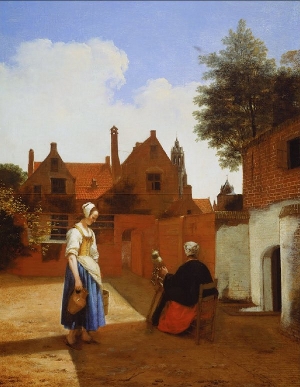 fig. 13 Courtyard in Delft at Evening: a Woman Spinning
fig. 13 Courtyard in Delft at Evening: a Woman SpinningPieter de Hooch
Oil on canvas, 69.3 x 53.8 cm.
1656–1657
The Royal Collection Trust, London
Painting in Delft
Why one center rather than another gives birth to a new and significant form of painting at a given moment is unknown. In Vermeer's time, Delft was a small town principally known for its prestigious ties to the Dutch nobility, its breweries, porcelain, tapestries, picturesque streets, canals, courtyards and cleanliness. However, Delft had immense historical and moral importance for the Dutch nation: it had been the focal point of activities which shaped the fate of all the United Provinces at the outset of the Eighty Years' War. Some of the nation's major figures had been born in Delft: the admirals Piet Hein (1577–1629) and Marten Harpertsz. Tromp (1598–1653); Prince Frederick Henry (1584–1647), the son of William the Silent (1533–1584) and one of the war's military heroes; Hugo Grotius (1583–1645), the jurist and statesman. Although small, Delft was rich and many of its citizens lived comfortably. The worth of its surrounding lands was calculated to be greater than that of Dordrecht, Schiedam and Rotterdam together. The tone of Delft's civic life, like its art, was conservative and profoundly patriotic. Delft's economic base was shrinking in comparison to booming Amsterdam and no longer had an active role in the nation's affairs.
Artistic production in Delft from 1600 to 1650 had been prodigious in portraiture, history painting, genre, landscape, still life, and architectural painting, but when compared to Haarlem or Amsterdam, both major artistic centers, it had only been of limited importance. Although conservative in subject matter and style, pre-School-of-Delft painting is nonetheless characterized by high standards of craftsmanship, refinement, and a tendency toward understatement and reserve. The love of Delft's aristocratic society for rare and well-made objects, including paintings, may have been enhanced by the arrival of exotic Asian wares unloaded on the town's inland dock by ships returning from the Far East—Delft was one of the VOC ( Dutch East Indies Company) headquarters.
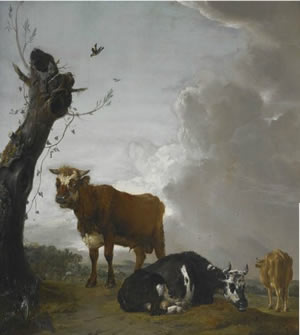 fig. 14
A Young Bull and Two Cows
fig. 14
A Young Bull and Two CowsPaulus Potter
1649
Oil on panel, 70.2 x 63 cm.
Royal Trust Collection, London
Despite its refinement, Delft painting in the first half of the seventeenth century lacked the dynamism of the high Baroque art—as Liedtke pointed out, there never was a "Delft Baroque."Walter Liedtke, Architectural Painting in Delft (Doornspijk: Davaco, 1982), 11. Modeling of form was sober and brushwork unobtrusive. Delft's principal artists tended to perpetuate established artistic traditions, some of which were imported from abroad, rather than innovate. The revolutionary art of Rembrandt and Frans Hals was completely ignored. Although Liedtke holds that essential qualities of Delft painting before 1650 link the School of Delft's art to the art of the town's past, many critics perceive an irreconcilable divide. Until the 1650s, the artistic production of Delft was closely intertwined with that of The Hague, which is no more than an hour's walk from Delft. A number of Delft painters worked for The Hague Court; satisfying the constant demand for high-quality portraits and history paintings.
Montias conjectured that in the 1640s, Delft artists still went their separate ways, "exempt for the most part from any leadership or even from strong currents of influence. No more disparate group of painters can be conceived than Michiel van Mierevelt, Balthasar van der Ast, Jacob Pynas, Anthonie Palamedesz, Simon de Vlieger, and Leonaeert Bramer, who were all active—and more or less successful—in Delft in the 1630s." John Michael Montias, “Painters in Delft, 1613–1680,” Simiolus: Netherlands Quarterly for the History of Art 10, no. 2 (1978–1979).
Even during the School of Delft's heyday, the heterogeneous group of Delft artists continued to produce a wide range of paintings and artworks: still life, portraits for patrons and the court, sophisticated history paintings for the Court at The Hague and for patrician collectors in Delft, as well as decorative pieces of art, luxurious tapestries and silver objects.
Why Delft?
Despite its lack of the economic prosperity necessary to sustain extensive patronage, Delft's enduring sense of quiet order is believed by some art historians to have played a key role in attracting artists. This tranquility, still apparent today, particularly evident during tourist off-seasons, contrasts sharply with the bustling activity of peak tourist times. It was commonly noted that Delft housewives were "fanatically clean," leading to Delft's reputation as "'not only the cleanest place in Holland but, perhaps, in the entire world,"a view echoed by Dirk van Bleyswijck, as quoted by a Cologne cartographer in 1696. The town's layout itself reflected this orderliness, with its rectilinear street and canal plan standing in stark contrast to the chaotic alleyways typical of Dutch urban landscapes at the time. Art historian Peter Sutton observed that 'the town's neat and orderly appearance, so reflective of its inhabitants' mentality, is most vividly expressed in the works of De Hooch and his contemporaries.' He further noted that 'the serene and refined art of De Hooch and Vermeer was well-suited to this conservative milieu.'
Walter Liedtke, however, emphasizes the importance of serendipity: 'The coincidental meeting of artists, whose diverse experiences and personalities sparked innovative ideas. Artists like Potter (fig. 14), Fabritius, De Hooch, De Witte, and Steen, familiar with the painting styles of Haarlem and Amsterdam, didn't choose Delft by a collective decision or for a uniform reason.' The absence of a dominant artistic tradition in Delft, or of a leading figure, may have provided ample opportunity for a new generation of painters, from varied cultural and artistic backgrounds, to mingle and experiment. Moreover, three pivotal historical events likely propelled these young Delft artists to diverge from tradition and venture into new artistic realms: the death of Prince Willem II in November 1650, the devastating explosion of Delft's gunpowder warehouse in 1654, which claimed many lives and led to significant reconstruction of the town, and the decline of the Hague court, stripping many Delft artists of their stable patronage.
By the mid-seventeenth century, Delft's approximately 50,000 residents, predominantly middle-class, owned an estimated 50,000 paintings, signifying the widespread cultural engagement and artistic appreciation within the town."
